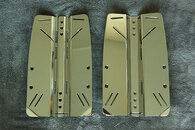the shape of this plate seems logical to me in that, outside of the scuba world, it makes a lot more since to sit a cylinder between two bent v's instead of up atop an inverted u. thing is, though, i can't find a major manufacturer actually producing a "double-v" shaped plate.
i'm just curious about more of the "why" for backplate shape and if i'm missing something regarding the "double-v" vs. "inverted u" shape of a scuba backplate.
Thanks for the interest in my designs.

The main thing you must consider is that the first metal backplates in the form that is common today were made specifically for use with twin tanks. There is an article around from the guy who supposedly created the first metal backplate from an old road sign describing how and why he created the design, basically to improve the stability of his double tank rig when cave diving over the simple harness they were using beforehand. (There used to be a PDF of this article on the Dive Rite web site, but I can't find it now.) Bolting a single tank adapter (the clue is in the name!) to the backplate to allow it to also be used with single tanks came later.
However, for exclusive use with a single tank, the inverted centre channel works really well. The main benefits gained are; simplicity (eliminating the STA, bolts, wingnuts etc) and that the tank sits closer to your back. Consider this comparison:
The tank sits about an inch closer to your back compared to a standard backplate/STA combination.
The main disadvantage is that a backplate with an inverted centre channel can't be used with twin tanks using bolts, so if you dive both single tanks and twinsets you need two backplates, which gets away from the multi-purpose concept of a backplate a bit. (Personally I have four plates in regular use - single tank steel, single tank aluminium, twin tank steel, twin tank aluminium - so I'm not the one to ask.

)
There is a bit more background about the design on my page about my first single tank plate (from 2003):
H-Plate
The only manufacturers that currently produce backplates like this that I am aware of are Golem (mentioned before, though I think they intend their plate more for use with rebreathers?) and Halcyon, with their new Traveller BC (with a plastic backplate), though several wing manufacturers (Deep Sea Supply, Oxycheq for two) make wings that don't require a separate STA. And there is nothing wrong with a backplate and STA combination in any case.
Note I'm not a manufacturer, just a hobbyist - and I made these largely for the pleasure of creating and diving my own designs. I'm also not really concerned with cost - just making something as optimally functional as possible.
I'd also mention that I don't claim that this is my original idea - there have been plastic backpacks that achieve the same end around for decades as other posters have mentioned, and before I started making my own plates there were other (now defunct) manufacturers making metal plates with inverted channels - Black Art from Australia were one, and Portland Oceaneering from the UK another.
Cheers,
Huw













